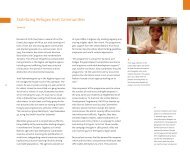Working It Out - christopher reardon
Working It Out - christopher reardon
Working It Out - christopher reardon
Create successful ePaper yourself
Turn your PDF publications into a flip-book with our unique Google optimized e-Paper software.
<strong>Working</strong> <strong>It</strong> <strong>Out</strong><br />
Can new alliances<br />
between job seekers and<br />
employers help bring<br />
prosperity for all<br />
BY CHRISTOPHER REARDON<br />
There’s no easy cure for the slumping U.S. economy, but this<br />
much appears certain: Growth will continue to lag unless the<br />
nation tackles what some experts describe as “an impending<br />
workforce crisis.”<br />
A big part of the crisis is a looming shortage of skilled labor.<br />
This was the focus of discussion earlier this year when 75 leading<br />
figures from business, labor, government, academia and the<br />
Christopher Reardon writes for The New York Times and other major<br />
publications.<br />
nonprofit sector met for the 102nd American Assembly, a public<br />
policy forum affiliated with Columbia University. As eight<br />
inches of snow fell outside their meeting room at Arden House,<br />
a sprawling granite manor in Harriman, N.Y., participants<br />
looked back on the 1990’s boom.<br />
The bull market, they noted, was fueled by the end of the<br />
cold war, rapid advances in computer technology, lower trade<br />
barriers and declining federal deficits. But it also benefited from<br />
a demographic bubble. Over the past 20 years, baby boomers<br />
reached their peak earning years and women and college grad-<br />
24 Ford Foundation Report Summer 2003
PHOTOGRAPHS BY M.J. SHARP<br />
uates entered the workforce in record numbers. Those trends<br />
have peaked, participants agreed, and in the coming decades<br />
the nation’s prosperity will hinge increasingly on the strength<br />
of its workforce.<br />
“There is a great deal at stake,” they said in Keeping America<br />
in Business: Advancing Workers, Businesses and Economic Growth,<br />
a report summarizing the four-day dialogue. (Copies are available<br />
online at www.opportunitiesatwork.com.) “Without aggressive<br />
action to expand the labor force in ways that increase<br />
productivity for employers, the nation’s long-term economic<br />
health will be challenged.”<br />
In the last 10 years, a growing number of organizations around<br />
the United States have embraced new workforce development<br />
approaches that help employers, job seekers and training providers<br />
find common ground and act upon shared interests. Some of<br />
these efforts began with community-based organizations. Others<br />
took root within employer groups, labor unions, community<br />
colleges, public agencies and staffing firms. Collectively, they<br />
came to be known as workforce intermediaries, a name that<br />
reflects their dual allegiance to job seekers and employers.<br />
Traditionally, many Americans spent their whole working<br />
life with a single employer, where job security and on-the-job<br />
training let them move up the career ladder. But those days are<br />
gone, and employers, educators and workers often struggle to<br />
find each other, interact in meaningful ways and gather resources<br />
for training. Increasingly, though, workforce intermediaries are<br />
helping to broker this process.<br />
Their work has begun to dispel the notion that federal and<br />
state support for employment training and placement is just<br />
an exercise in social policy, if not simply a handout to the poor.<br />
Increasingly, creating opportunities for low-income job seekers<br />
is gaining recognition as a matter of economic policy.<br />
For much of the last decade, the Ford Foundation has tested<br />
the proposition that workforce intermediaries can help revitalize<br />
the nation’s ailing and fragmented workforce system. One<br />
line of grants supports programs that train workers for targeted<br />
industries with plenty of job openings and opportunities for<br />
advancement. For example, Focus: HOPE in Detroit is training<br />
low-income residents for promising careers in machine work and<br />
information technology. Another line of grants, known as the<br />
WINs initiative—short for Workforce Innovation Networks—<br />
is exploring ways that employer groups can help small and midsize<br />
companies meet their staffing needs while helping low-skilled<br />
workers find stable jobs that can sustain their families.<br />
WINs grew out of the foundation’s Corporate Involvement Initiative,<br />
which seeks to engage the private sector in community<br />
and economic development in ways that benefit both low-income<br />
people and businesses. <strong>It</strong> seems to be catching on. Last winter the<br />
U.S. Department of Labor made a $4.2 million grant allowing<br />
12 additional local workforce intermediaries and three statewide<br />
teams to join the WINs initiative. The new sites will be announced<br />
Opposite Aisin AW’s Toyota<br />
transmission plant in Durham,<br />
N.C. The firm expanded the<br />
plant in part because the<br />
community was ready to prepare<br />
workers for the new jobs.<br />
The Changing<br />
later this summer.<br />
Jobs for the Future, one of<br />
three national organizations<br />
leading the initiative, is concentrating<br />
on efforts to erect<br />
career ladders: training and<br />
other supports that help workers<br />
advance through a progression of jobs in a single field. The<br />
Greater Cleveland Growth Association, for instance, is trying to<br />
streamline opportunities for training, placement and advancement<br />
in health care, a burgeoning local industry. Similar efforts<br />
are under way in Pittsburgh and San Francisco.<br />
The National Association of Manufacturers, another WINs<br />
affiliate, aims to improve job retention and advancement at<br />
companies in Detroit, Pittsburgh and Hartford, Conn. Basil<br />
Whiting, a senior fellow at the association’s Manufacturing<br />
Institute, sees these efforts as a logical next step for the workforce<br />
system. “In the 60’s we trained employees,” he says. “In<br />
the 90’s we trained them, placed them, found them transportation<br />
and arranged child care. But still nobody went inside<br />
the firm and asked: How good are the supervisors Can they<br />
lead Can they communicate”<br />
Welfare reform has brought this blind spot into focus, Whiting<br />
says. If the goal is not just to reduce caseloads but to help<br />
people find gainful employment, there should be closer attention<br />
to what happens after they enter the workplace. Small and<br />
midsize companies are often reluctant to hire low-income workers,<br />
in part because they lack the in-house resources to train<br />
them. Through WINs, the association is helping such firms<br />
develop personnel handbooks, set up orientation programs,<br />
assign mentors and train supervisors—proven ways to boost<br />
productivity and job satisfaction.<br />
The U.S. Chamber of Commerce is the third national WINs<br />
affiliate. Through its Center for Workforce Preparation, the<br />
chamber is working to integrate the needs of job seekers and<br />
business leaders in Holyoke, Mass.; El Paso, Texas; and Durham,<br />
N.C. “We’re all asking the same question,” says the center’s executive<br />
director, Beth Buehlmann, who helped organize the assembly<br />
last winter. “What can we do to create an environment where<br />
low-income people can build careers—not just find jobs—<br />
and meet employers’ needs for a skilled workforce”<br />
One answer lies with employer groups like the Greater<br />
Durham Chamber of Commerce, which seeks to promote economic<br />
growth in ways that benefit people from all walks of life.<br />
Another comes from community groups like Detroit’s Focus:<br />
HOPE, which is testing new ways to pay for its highly successful<br />
training programs.<br />
Durham: Fighting Poverty in Prosperity’s Shadow<br />
In 1998 a Japanese firm called Aisin AW decided to build a<br />
new plant in the United States to make transmission components<br />
for Toyota Camrys assembled in West Virginia. After looking at<br />
100 communities in eight southern states, it picked Durham,<br />
N.C. Even in that flush era, it was a nice catch for the city. Aisin<br />
invested $100 million in land and production facilities and created<br />
350 jobs. But that wasn’t all. Two years later the manufacturer<br />
decided to expand its U.S. presence. Again it picked<br />
Durham, investing an additional $160 million and creating<br />
another 450 jobs.<br />
Why Durham Like many of the proposed sites, it had good<br />
infrastructure and affordable labor. But one thing made it stand<br />
out: its readiness to prepare workers for the new jobs. “A lot of<br />
factors came into play,” says Will Collins, manager of human<br />
resources for Aisin’s local subsidiary, AW North Carolina. “One<br />
was Durham Tech, our community college. Their faculty has<br />
Workplace<br />
Ford Foundation Report Summer 2003 25
designed individualized programs based on the openings we<br />
have, and that has proven very successful.”<br />
Durham’s reputation for pioneering new approaches to workforce<br />
development dates back more than 20 years. In the early<br />
1980’s, leaders from the public and private sectors joined forces<br />
to help women on welfare gain access to well-paying jobs in the<br />
electronics industry. More recently, through WINs, the city has<br />
been forging closer links between economic development and<br />
employment training. The Greater Durham Chamber of Commerce,<br />
which is coordinating these efforts, recognizes that an<br />
adaptable workforce can be a valuable asset. “Our specialty is<br />
helping to recruit new industry and helping existing industry<br />
to expand,” says Thomas J. White, the chamber’s president and<br />
C.E.O. “<strong>It</strong> just seems like a logical extension of that function to<br />
include job training.”<br />
White, who came to Durham 31 years ago to attend Duke<br />
University, says the city is blessed by its proximity to Research<br />
Triangle Park, a cluster of 140 high-tech firms that share a 7,000-<br />
acre campus 10 miles from downtown. Along with Duke and<br />
its medical center, the park has turned the city into a technological<br />
dynamo. But the economic climate remains grim downtown,<br />
where many tobacco warehouses and textile mills have<br />
closed in recent decades, putting more than 10,000 local residents<br />
out of work.<br />
“We still have a lot of poverty in Durham,” White says. “Nineteen<br />
percent of our children and 12 percent of our adults live<br />
below the poverty line. The really disturbing thing about that is<br />
that in the 1990’s, when we led the state for a number of years<br />
in new industry, few inner-city residents got access to those jobs.”<br />
Through WINs, the chamber is exploring ways that dislocated<br />
workers, people on public assistance and at-risk youth can<br />
contribute to—and benefit from—the region’s vital economy.<br />
Making the workforce system more responsive to employers<br />
may go a long way in creating<br />
such opportunities, says White.<br />
Efforts are under way to<br />
increase the number of companies<br />
that use the system,<br />
bridge gaps in service delivery<br />
Trainees at Durham Tech learn<br />
to use a lathe. The faculty has<br />
designed individualized programs<br />
based on local industry<br />
openings, which has proved<br />
very successful.<br />
and minimize duplication of efforts. The chamber, for example,<br />
is preparing a workforce resource guide for employers as<br />
well as an orientation package encouraging them to join the<br />
local workforce investment board, which works with elected<br />
officials to oversee the job-training system. Among its newest<br />
members is Will Collins from AW North Carolina.<br />
This spring Collins began hiring workers to staff the manufacturer’s<br />
expanded plant. About 40 trainees will join the staff<br />
each month until all 450 new positions are filled. “Our goal is<br />
to maximize the number of TANF and WIA participants who<br />
get access to those jobs,” says White, referring to two federal<br />
programs (Temporary Assistance for Needy Families and the<br />
Workforce Investment Act) that fund employment training for<br />
low-income people. “But getting entry-level jobs at $11.50 an<br />
hour is just the start. I envision people taking advantage of the<br />
tuition-reimbursement plan, enrolling at Durham Tech and<br />
getting associate degrees. That gives them promotional opportunities.<br />
Maybe some will go on and get a baccalaureate degree<br />
in mechanical engineering.”<br />
Earlier this year, White testified before a House subcommittee<br />
about American competitiveness in the 21st century. He spoke of<br />
the chamber’s overlapping interests in promoting capital investment,<br />
expanding the tax base, creating jobs and reducing poverty.<br />
“Our communities, our states and our nation are far more<br />
competitive and more productive when we design and operate<br />
a workforce system that includes business and government as fullfledged<br />
partners,” he said. “When our nation’s workforce sys-<br />
26 Ford Foundation Report Summer 2003
Durham’s Chamber of Commerce is<br />
helping to recruit new industry and<br />
helping existing industry to expand.<br />
‘<strong>It</strong> just seems like a logical<br />
extension to include job training,’<br />
says Thomas J. White, who<br />
heads the chamber.<br />
tem is fully integrated with our economic development<br />
system … our citizens can take advantage of<br />
and reap the benefit from the economic opportunities<br />
created by new and expanding industry.”<br />
White says the best measure of progress will not<br />
be the number of jobs created or the rise in average<br />
household income. “By 2010 I hope to see Durham’s<br />
poverty rates slashed by a few percentage points,” he says. “Then<br />
we’ll know we’re getting somewhere.”<br />
Detroit: Covering the Cost of Success<br />
One of the most ambitious—and successful—job-training<br />
programs in the United States prepares teens and young adults<br />
in Detroit for careers in the manufacturing trades. Since 1981<br />
more than 2,500 students have graduated from the Machinist<br />
Training Institute at Focus: HOPE, a community development<br />
corporation formed soon after the 1967 riots.<br />
Students at M.T.I. use lathes and grinders to create their own<br />
sets of tools, including hammers and clamps, while learning<br />
about precision machining and metalworking. They also take<br />
courses in blueprint reading, computer-aided design and computer-aided<br />
manufacturing. The average starting salary for graduates<br />
is $11 an hour, but many alumni earn salaries of $40,000<br />
or more after a few years with firms like General Motors and<br />
Northwest Airlines.<br />
In 1995 Focus: HOPE conducted a study to see if society was<br />
benefiting, too. The study found that it took an average of 3.1 years<br />
for graduates to pay in taxes an amount equal to the cost of their<br />
training. After factoring in the savings in food stamps, but not<br />
other forms of public assistance, it calculated the annual return<br />
on investment at 41 percent since the program’s inception.<br />
“That’s not too bad,” says Kenneth Kudek, Focus: HOPE’s<br />
assistant director of education, with great understatement. “If<br />
only PaineWebber or Merrill Lynch could guarantee that kind<br />
of a return for 13 years running!”<br />
Nevertheless, since welfare reform took effect six years ago,<br />
government funding has been driven by a “work first” approach<br />
that favors rapid job placement over pre-employment training.<br />
That leaves Focus: HOPE holding much of the bill for M.T.I. and<br />
its newer Information Technologies Center, which began offering<br />
computer instruction in 1999. <strong>It</strong>s courses range from a twoweek<br />
program in keyboard and mouse skills to a 40-week<br />
program in network administration. Graduates typically find jobs<br />
starting at $13 an hour.<br />
Both programs have proven successful in launching productive<br />
careers, but covering the costs has not been easy. Tuition<br />
for 31 weeks of instruction in the machining program runs<br />
$9,250, while 40 weeks of half-time training in network administration<br />
costs $9,000. Focus: HOPE spends $5 million a year to<br />
run the two programs.<br />
Grants from foundations<br />
and other private donors pay<br />
for about 25 percent of the<br />
training costs. State and federal<br />
agencies used to reimburse<br />
Focus: HOPE for much<br />
of the rest, but this support<br />
has been falling sharply. In<br />
recent years government programs<br />
like TANF and WIA<br />
have covered only half the<br />
cost, causing Focus: HOPE’s<br />
education program to run up<br />
a $1.1 million deficit.<br />
Focus: HOPE covered the<br />
shortfall with money from its<br />
general funds, but its staff knew that wasn’t a long-term solution.<br />
So three years ago they set up a revolving student loan<br />
fund in hopes that graduates and their employers would contribute<br />
to the cost of training. The Ford Foundation made a $3<br />
million program-related investment to help capitalize the fund.<br />
Other private foundations, banks and individuals contributed<br />
another $8.8 million.<br />
Now students sign a loan agreement upon enrolling at M.T.I.<br />
or I.T.C. After graduating, they repay the loans through regular<br />
payroll deductions. So far the fund has issued more than<br />
$16 million in loans. Fees from government agencies have covered<br />
$7 million of this amount, leaving 3,100 borrowers with a<br />
total obligation of $9.3 million, an average of $3,000 per person.<br />
Recent graduates have already paid back more than $1 million.<br />
“We were looking for a sustainable way to cover the rest of<br />
our training costs,” says Kudek. “Now, as students graduate and<br />
become successful, they can invest back in their younger brothers<br />
and sisters.”<br />
Focus: HOPE is trying to coax employers to contribute, too.<br />
General Motors and Northwest Airlines now pick up half of<br />
the outstanding balance when hiring M.T.I. and I.T.C. graduates,<br />
usually by matching their loan payments dollar for dollar.<br />
But the recession has hit Michigan hard, preventing other companies<br />
from following suit. That, along with hiring freezes and<br />
layoffs at many local firms, has put a strain on recent graduates,<br />
nearly half of whom are behind in their payments.<br />
The high number of delinquencies and defaults is not altogether<br />
surprising, given that Focus: HOPE lends to people other<br />
creditors avoid. But they could threaten the fund’s long-term viability.<br />
To help boost the repayment rate, Focus: HOPE is studying<br />
the impact that different co-payments, interest rates and<br />
repayment schedules have on loan outcomes. <strong>It</strong> is also adding<br />
courses in financial management and household budgeting and<br />
considering assigning a financial mentor to each borrower as a<br />
condition of the loan.<br />
In the coming years, Focus: HOPE will look for ways to make<br />
the fund efficient enough that other training programs around<br />
the country will follow its lead.<br />
“This design brings all of the stakeholders to the table,” says<br />
Kudek. “<strong>It</strong> lets taxpayers, employers and students share the costs<br />
as well as the benefits of developing a skilled workforce.” ■<br />
Ford Foundation Report Summer 2003 27









